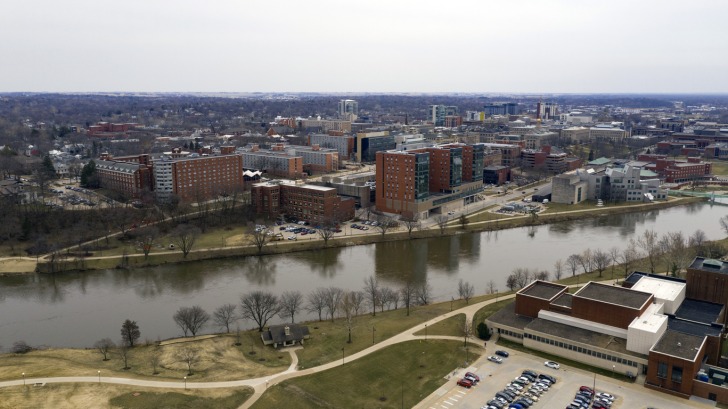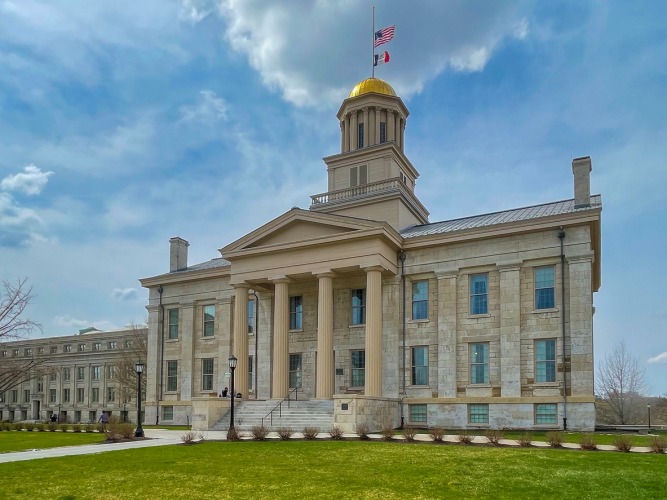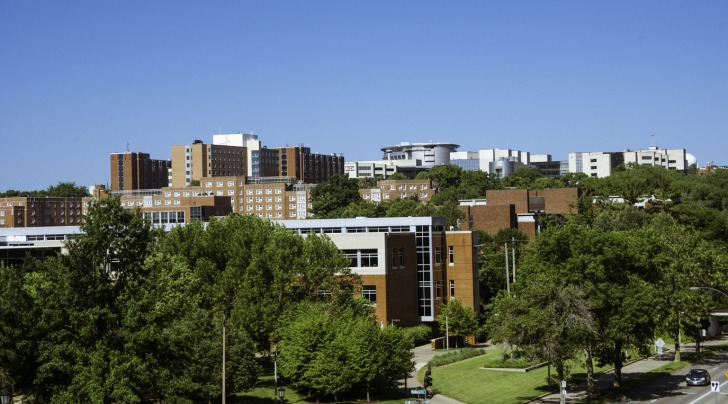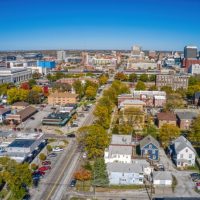Iowa City is a relatively small city in Eastern Iowa with about 52,000 residents.
It has the University of Iowa, and that may be the ingredient that makes it a very youthful and lively town.
The city is known as a center for writers and artists and has a lot of great things that make it a desirable place to live.
There are some downsides, but they may not be enough to keep people away.

Contents
Pros of Living in Iowa City
1. Housing Is Cheap
Housing in Iowa City, Iowa, is 21 percent cheaper than the national average and is higher than the state average.
The average home price in Iowa City is $283,000, and the state average is $212,000.
That’s still well below the national average of $416,000.
Homes have been going up in value in Iowa City, as much as five percent last year so buying a house could be a good investment.
The average rent is about $1300, and nationwide that average is $1700.
2. The Cost of Living Is Low
In addition to lower-cost housing, about everything else in Iowa City is also less expensive than elsewhere.
The cost of living includes hosting, utilities, food, clothing, taxes, and a few other items, all averaged together.
Housing makes Iowa City’s cost of living lower, but other things are reasonable too.
Utilities, food, and healthcare of cheaper than the national average.
Transportation and general goods and services are more than the national average.
3. The University of Iowa
The university is the main state university and is respected nationwide as a major college.
It usually has good sports programs, and its academics are among the best.
This means there are a lot of young people in Iowa City from various backgrounds.
There’s plenty of opportunity for adults to continue their education or learning there as well.
A small town with a solid university tends to have a lot of well-educated residents.
4. Quality of Life
Iowa City was named one of the best cities for families in the nation by Fortune magazine recently.
It has a vibrant downtown in addition to the major university.
There are lots of festivals and events to go along with the sports from the university.
There are three farmers’ markets in the city too, so you can get plenty of fresh food.
It has many of the amenities of a large town, but it also maintains some small-town charm.
The Iowa River flows through the town, and that is always a benefit to most towns.
5. Literary Connections
In 2008 Iowa City was named a UNESCO City of Literature and is only the third city in the world to have this designation.
The University of Iowa’s graduate writing program is regarded as one of the best anywhere.
The city has a well-earned reputation for being a home for writers.
The writing program has turned out 12 Pulitzer Prize winners, and four US Poet Laureates.
6. The Arts
Iowa City calls itself “The Greatest Small City for the Arts,” and it seems to have a legitimate claim to the title.
There are dozens of murals depicting many aspects of Iowa City, from entire blocks with one painting to buildings with several.
There is a classic movie theater, a few venues for live theater, and a solid live music scene as well.
There are several art museums of many kinds and some new art in Iowa City.
7. Farmers Markets
Iowa City is surrounded by farmland, so it makes sense there would be a lot of locally grown food available.
There are two very large farmers markets in Iowa City that run through the summer months.
It doesn’t end there though.
They have a winter market that is also very large, selling local produce, baked goods, coffee, jewelry, and more.
Not many cities, especially in the North, can offer year-round fresh produce.
8. Downtown
The downtown area has been restored and still has a historic flair.
There are 70 or so privately owned and run stores of many kinds.
There is a wide variety of restaurants of many food styles as well.
The great number of college students also helps give the downtown a sense of vitality.
There are always music or theatrical performances happening downtown as well.
Iowa City is always highly ranked among the best party schools in America.
The downtown area is also great for walking with no cars allowed.
Cons of Living in Iowa City
1. The University of Iowa
This is also a positive, but it can be hard on locals on game day during football or basketball season.
The town can get very crowded on those days, and while it’s great for tourists, it gets old for people who live there.
There are a lot of benefits to having a major state university in your town, but there is that downside of occasional overcrowding to contend with.
2. Not Enough Hospitals or Schools
Iowa City has some outstanding hospitals, and some outstanding schools, but there are just not enough of them.
The hospitals are not enough to serve the metropolitan area.
There is also a lack of school choices outside the city where rural people live.
If you live close to the hospital you may get great care, but if you don’t, you may struggle.
You also have to travel to get certain specialists.
3. Severe Weather
The city has four seasons, which is good.
Winters are very cold and there is often a lot of snow.
There is usually about 8-10 inches of snow in December and about 30 days of at least an inch of snow each year.
It is also very cold. It is at high risk for tornadoes and has had some devastating storms.
There was flooding in 2008 that caused $6 billion in damages.
The winter lasts for about four months.
Spring and fall are usually nice, and summers can get pretty hot too.
4. Not Tax-Friendly
Iowa City has the fifth-highest property tax rate in the state at $40 per $1000 of value.
Iowa is not known as a tax-friendly state and Iowa City follows that mold.
The state has the 17th highest income tax rate in the nation.
Iowa City also has a six percent sales tax.
Iowa’s tax system is ranked 38th in the nation.
Iowa also has a high corporate tax rate of 9.8 percent.
Iowa City is relatively friendly to retirees in that social security income is not taxed.
5. Little Diversity
Even with the university, there is not a lot of diversity in the city.
The population is 78 percent white, eight percent black, and seven percent Asian, Iowa City did recently elect its first black mayor, so it is possible for minorities to advance here, it’s just that there are not a lot of them.
There are very few Native Americans.
While most of Iowa is predominantly white farmers, Iowa City tends to have less diversity than the rest of the state.
6. High Poverty Level
Some estimate that 27 percent of the people in Iowa City live below the poverty level.
They may have jobs, but work at low-paying jobs.
The national average is 12.8 percent.
There are jobs available, but pay is low and has not increased in the face of inflation in recent years.
The per capita income in Iowa is $34,000 and it is about $32,000 in Iowa City.
The high poverty rate has not made the crime rate go up, which it does in many places.
The crime rate is slightly below the state average.
7. Rent Is Higher
Probably due to there being a large university in town, rent prices are often high in Iowa City even as the cost of houses is not very high.
The median rent in Iowa City is $1,925.
It ranges from a low of $300 to a high of $3,000.
It is higher than the national average of $2,700.
Renting a house in Iowa City is far above the state average of $1,050.
8. Not Close to Major Cities
It is not far from Cedar Rapids or Des Moines, which are larger towns, but it is a long way to a large city like Chicago or Minneapolis.
Transportation can be an issue if you don’t have your own car.
It does have a bus service that runs Monday through Friday, but not on weekends.
There are not a lot of options for traveling to other cities.

Pros and Cons of Living in Iowa City, IA – Summary Table
| Pros of Living in Iowa City | Cons of Living in Iowa City |
|---|---|
| 1. Housing Is Cheap | 1. The University of Iowa |
| 2. The Cost of Living Is Low | 2. Not Enough Hospitals or Schools |
| 3. The University of Iowa | 3. Severe Weather |
| 4. Quality of Life | 4. Not Tax-Friendly |
| 5. Literary Connections | 5. Little Diversity |
| 6. The Arts | 6. High Poverty Level |
| 7. Farmers Markets | 7. Rent Is Higher |
| 8. Downtown | 8. Not Close to Major Cities |
Iowa City Safety Overview
READ THE FULL REPORT: Iowa City Safety Review
Safety Index:
- OVERALL RISK: LOW
- TRANSPORT & TAXIS RISK: LOW
- PICKPOCKETS RISK: LOW
- NATURAL DISASTERS RISK: MEDIUM
- MUGGING RISK: LOW
- TERRORISM RISK: LOW
- SCAMS RISK: LOW
- WOMEN TRAVELERS RISK: LOW
Frequently Asked Questions
What is the crime rate in Iowa City?
The crime rate is not particularly high in Iowa City.
It is slightly below the state average, and slightly above the national average.
In Iowa City, you have a one in 148 chance of being a violent crime victim, and in the state in general your chances are one in 331.
Property crime is similar, slightly above the state average and below the national average.
What is the unemployment rate?
The unemployment in the Cedar Rapids – Iowa City metropolitan area is at about four percent, which is up from three percent last year.
The unemployment rate in Iowa overall is 2.9 percent, the 20th highest in America.
The national rate is 3.8 percent.
What is some basic history of Iowa City?
The city was founded in 1839 and incorporated in 1853.
It was the state capital from 1840 until 1855 when it was moved to Des Moines.
Iowa City was created by a state decree to house the state capital.
The old Iowa Capital Building may still be toured.
Is it easy to get around in Iowa?
The short answer is no.
It is a rural state, and often there is a long distance between cities.
There is not a lot of public transportation, so you have to have a car to go anywhere for the most part.
It is 115 miles, for example, to Des Moines the largest city in the state.
What jobs are most common in Iowa City?
There are more nurses, 4,100, than any other profession in the city and these are high-paying jobs.
Retail sales, cashiers, fast food, and counter workers are the next most common jobs in the city.
Each of those makes up about two percent of the total job force.
The pay is generally lower, but the cost of living is lower too.
Professional-level jobs pay well, but lower-level jobs are below average in pay.












I am proud to call Iowa City my home so I thought I might share my thoughts. Iowa City is one of those places that kinda sneaks up on you. The artsy vibe here is seriously legit. From the cool indie theaters to the thriving literary scene, this town is a haven for the creative-minded. Safety-wise, it’s definitely a secure place, and you can comfortably explore the Downtown area, even at night. I found myself exploring places like the Old Capitol and the Iowa Avenue Literary Walk late into the evening without a second thought.
My experience of retiring in Iowa City has been nothing less than fulfilling. Safety is a top priority, and the city’s neighborhoods, like Northside and Manville Heights, offer a profound sense of security. The residents are amiable, and the local community organizations promote a genuine sense of togetherness which is hard to come by these days. Iowa City is where tradition seamlessly meets modernity, and for retirees, it’s a secure and culturally vibrant place to call home. The unhurried pace of life here is a blessing, believe me!